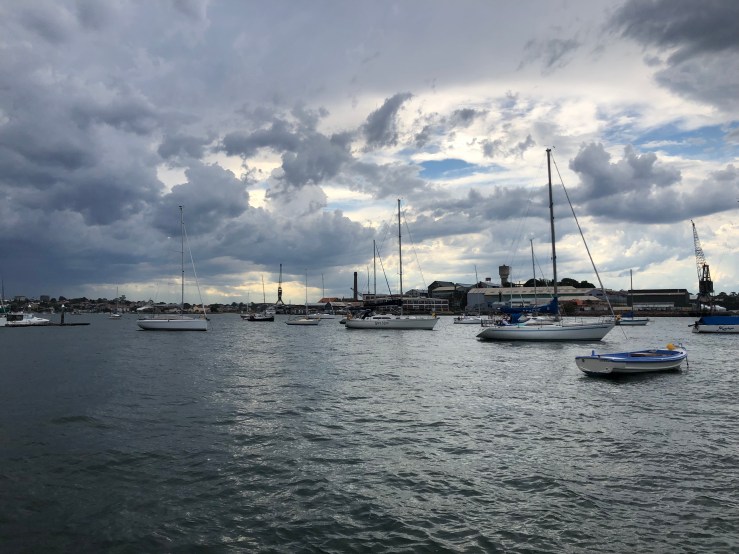“Reef the main!” – Joris shouted. I got to the halyard while he leaped to the other side to the reef lines. The main sail started coming down, flapping wildly in the wind.
“Stop!” – yelled Marco. “The slug! The slug is out!”
I looked at the main. The middle part of it was out of the track. We were screwed. Did it just show 35 knots on the wind instrument? The rain was belting down so hard, it felt like hail. Or was it actual hail? It hung in the air like a semi-transparent blanket so we could barely see the land in front of us and some boats a few metres away. We were all totally drenched, not a single offshore jacket between us.
“Let’s drop the main,” – said Greg and started the motor.
“It’s not coming down unless I climb the mast!” – said Marco.
It was a Friday twilight, another relaxed social race after a long work week. Only this time it turned out to be slightly less relaxed than normal.

It started off as a beautiful sunny afternoon but as I was getting on the boat at the club we were staring at the horizon. “Some interesting cloud formations over there,” someone said as another lightning struck. It was clear we’d get soaked at some point of the race but none of us minded that much.
The race committee (or rather our old mate Dave, the manager) chose the shortest course, and it was shortened even further after we started. It was dramatic enough for us from the start. A shorter course means that the division with biggest and fastest boats that starts last quickly converges with previous divisions. In the limited space between islands of the West Harbour it turns into dodge’em cars. Our troubles started even earlier though. As we were beating up to the top mark in a very fresh breeze, a boat above us seemed to bear down on us despite our yells.
“Watch your rig!” – our skipper yelled as their mast leaned further and further towards ours.
As we lost height, we got close to the mark and it turned out we had no room with two boats on top of us. There was nothing to do but bear away and do a 360. The two boats above us seemed to keep yelling at each other. We were now well behind everyone.
It started raining soon after and hush fell over the water. No wind. We adjusted sails and moved crew weight around and we crept forward. Then the storm hit us.
Nobody panicked. We had experienced crew that night and people knew what to do. It felt surreal to experience this kind of weather at a twilight but I caught myself grinning ear to ear. We sailed normally for a while, water collecting on the main and landing on my head on top of the torrential rain. Then we got even more wind and heeled more and more, it became clear we had to reduce our sail area – hence the call to reef the main.
We did manage to get both sails down somehow, radioed the club and motored back. I looked at the blisters on my hands and thought of nothing but sailing. The raging flood of thoughts and helplessness that didn’t let me sleep the night before and gnawed at me all hours of the day that week, was gone. I looked at Chris’s 20 year old daughter who was a guest on the boat that night and smiled at her.
“That was scary! I thought we were going to capsize” – she said in her English accent. As I explained to her that capsizing a sailing yacht is not that easy, I kept thinking that I wasn’t planning to do much on the boat that night as we had plenty of experienced people but ended up doing my regular job anyway with no debate from anyone. What a difference from when I first got on that boat all those years ago when it was a privilege to be a sewer rat who helped getting the spinnaker down through the hatch. How I fretted that I lost all my muscle strength, all my trimming knowledge while on maternity leave. None of it mattered that much in the end.
I could breathe again. I could sail again.